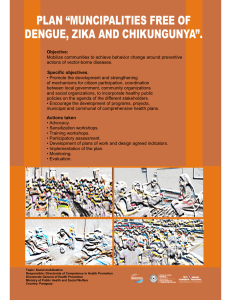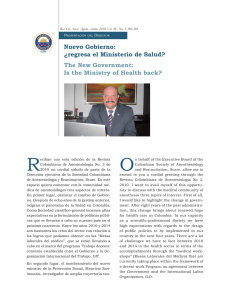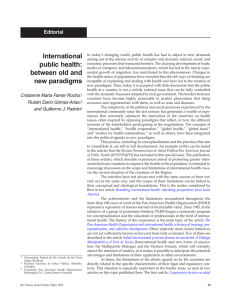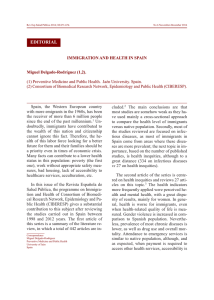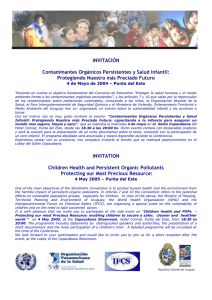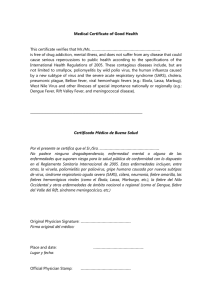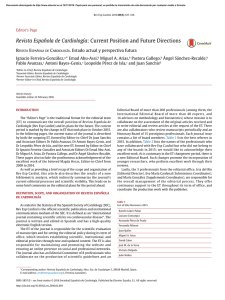pals don`t evaluate pals… or do they?
Anuncio
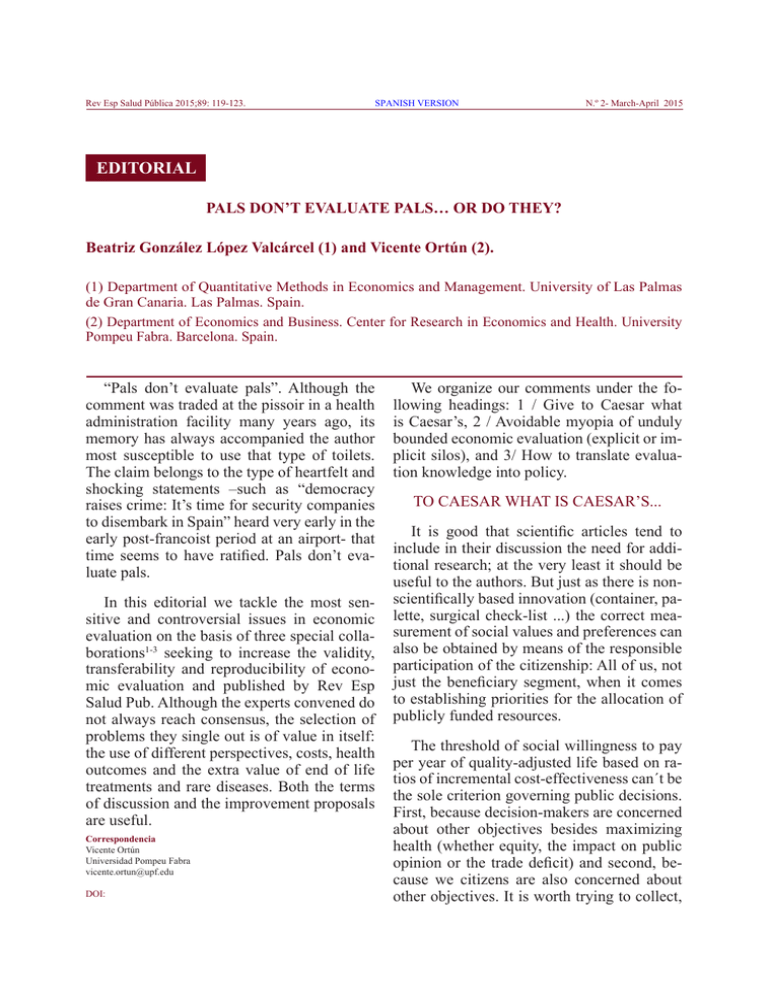
Rev Esp Salud Pública 2015;89: 119-123. SPANISH VERSION N.º 2- March-April 2015 EDITORIAL PALS DON’T EVALUATE PALS… OR DO THEY? Beatriz González López Valcárcel (1) and Vicente Ortún (2). (1) Department of Quantitative Methods in Economics and Management. University of Las Palmas de Gran Canaria. Las Palmas. Spain. (2) Department of Economics and Business. Center for Research in Economics and Health. University Pompeu Fabra. Barcelona. Spain. “Pals don’t evaluate pals”. Although the comment was traded at the pissoir in a health administration facility many years ago, its memory has always accompanied the author most susceptible to use that type of toilets. The claim belongs to the type of heartfelt and shocking statements –such as “democracy raises crime: It’s time for security companies to disembark in Spain” heard very early in the early post-francoist period at an airport- that time seems to have ratified. Pals don’t evaluate pals. In this editorial we tackle the most sensitive and controversial issues in economic evaluation on the basis of three special collaborations1-3 seeking to increase the validity, transferability and reproducibility of economic evaluation and published by Rev Esp Salud Pub. Although the experts convened do not always reach consensus, the selection of problems they single out is of value in itself: the use of different perspectives, costs, health outcomes and the extra value of end of life treatments and rare diseases. Both the terms of discussion and the improvement proposals are useful. Correspondencia Vicente Ortún Universidad Pompeu Fabra vicente.ortun@upf.edu DOI: We organize our comments under the following headings: 1 / Give to Caesar what is Caesar’s, 2 / Avoidable myopia of unduly bounded economic evaluation (explicit or implicit silos), and 3/ How to translate evaluation knowledge into policy. TO CAESAR WHAT IS CAESAR’S... It is good that scientific articles tend to include in their discussion the need for additional research; at the very least it should be useful to the authors. But just as there is nonscientifically based innovation (container, palette, surgical check-list ...) the correct measurement of social values and preferences can also be obtained by means of the responsible participation of the citizenship: All of us, not just the beneficiary segment, when it comes to establishing priorities for the allocation of publicly funded resources. The threshold of social willingness to pay per year of quality-adjusted life based on ratios of incremental cost-effectiveness can´t be the sole criterion governing public decisions. First, because decision-makers are concerned about other objectives besides maximizing health (whether equity, the impact on public opinion or the trade deficit) and second, because we citizens are also concerned about other objectives. It is worth trying to collect, Beatriz González López Valcárcel et al. weigh and scientifically assess other objectives such as preventing further damage in the future, encourage scientific and technical innovation, treat the socially disadvantaged, look after the ‘end of life’ or be sensitive to rare diseases. The articles commented gather the advancements along those lines, advances that must be complemented, even replaced, with an institutional change promoting the legitimacy of the decision-making process to arouse a wider social agreement as the results of the economic evaluation are perceived as a reflection of social preferences. Considering the lability and time-inconsistency of preferences, the role of emotions, and the relative ignorance about how such preferences are generated and, on the other hand, the knowledge about the framing effect –choices depending on how the problem is formulated– and about the important limits to rationality, credit is due to Science’s God but we must render unto the social functioning Caesar the practical measures for its improvement. AVOIDABLE MYOPIC ECONOMIC EVALUATION Economic evaluation is applied to a disease or group of diseases within a healthcare context when alternative uses of public resources are in housing, transport and education. This short-sightedness when accompanied by a tunnel vision, as fostered by a silos analysis, produces virtual blindness. The specific funding for antiviral therapy for hepatitis C a much of a silo as the consideration in isolation of health benefits (Pharmacy, hospitalization, primary ...) as if they were not substitutable among them, or the cancer silos that the United Kingdom is beginning to reconsider.4 The silo enshrines the denial of the very basic concept of always taking into account the benefit we lose in the best available alternative. Without reaching the silo extremes, we incur myopia when we compare the ‘chronically healthy child’ and ‘chronically healthy girl’ programs, since it appears that, if we were to follow the moral imperative of efficiency, we should analyze the program of the 120 ‘helpless and potential functional illiterate infant ‘ –focusing in its early years, even in utero (fetal alcohol syndrome), as it seems that as much for health/welfare reasons as for justice, no public investment exceeds the one in education5, particularly elementary and preschool education, since it facilitates equality of opportunity, prevents poverty from becoming dynastic and mobilizes the best human resources without discrimination by social class6. To be sure, it would appear to be much more cost-effective than two million euros per quality-adjusted life year with lapatinib as second-line breast cancer treatment (€ 18,299 for 0.3 months, € 732,000 by twelve months, € 2,000,000 per year if you take into account the low quality of the ten days gained).7 Stated more generally: if we are concerned with health, action shall be taken on its most vulnerable determinants and there where greater efficiency would be achieved. But while the methods for the economic evaluation of ‘hard’ technologies have been gradually standardized (the three articles that we comment are an example), the public health policy impact assessment and the cost-effectiveness analysis of public health community interventions are still methodologically wide open, suffer from inference technical problems, its external validity is doubtful, because human behavior comes into play, which is much more uncertain and variable than the physiological parameters of human organs, and there are no incentives to finance the necessary studies because no exploitable patents would result from them. FROM KNOWLEDGE TO IMPLEMENTATION Spain has advanced significantly more on knowing how to evaluate correctly, and doing so, than in translating that knowledge into action. We have more health technology evaluation agencies than any other country and since the Medicines Act of 19908 there is a regulatory framework for the economic evaluation of pharmaceuticals, extended to other benefits by Royal Decree 1030/20069 and revalidated Rev Esp Salud Pública 2015. Vol. 89, N.º2 PALS DON’T EVALUATE PALS…OR DO THEY? by Royal Decree-Law 16/201210. So despite the existence of an important evaluative capacity, major difficulties in the political arena (transparency, governance) prevent incorporating economic evaluation into healthcare decisions, as argued by Artells, Peiró and Meneu11. In hindsight, it is surprising that Spain has resisted the generalized regulatory movement introduced in Europe by the fourth guarantee (in 15 European countries, economic evaluation is formally required for reimbursement of drugs). The burden of proof seems, at this stage of XXIst century, on the side of the Spanish regulator, which is the rare exception in the European environment. Moreover, the explicit rationality in coverage and reimbursement decisions should relieve governments. It prevents arbitrariness and avoids the side effects of indiscriminate linear cuts and hasty decisions spurred by threats –short term exogenously imposed spending cuts, fear of losing votes–. A strong and independent agency, NICE style, offers clear advantages to any government: better resilience to the blackmail and pressure of the patient groups dancing to the sound of the industry’s music, enhanced purchasing power, better prices for new therapies, and provision of horizontal equity guarantees for the citizens. Do not forget that the British NICE was born to end the postal code effect: depending on where you lived, you would receive treatment or not. That’s why it is so surprising that this step has not been taken parallel to the evaluation of clinical or therapeutic quality, where we have advanced (therapeutic positioning reports or hepatitis C strategic plan hepatitis C). It seems, therefore, that the argument might not be that ‘pals don´t evaluate pals’. Paradoxically, in fact, it is the pals of hospital pharmacy services, from different Spanish hospitals, who have set up an unofficial and horizontally coordinated tool with the GENESIS project (Grupo de Evaluación de Novedades, Estandarización y Selección de Medicamentos). The group GENESIS assesses new medicines and replaces, however precariously, the rationally containment spending Rev Esp Salud Pública 2015. Vol. 89, N.º 2 and budgetary discipline functions. In seven years of work, GENESIS has issued over 1,000 evaluation reports, in contrast with the seven therapeutic positioning official reports approved in two years. The introduction of formal cost-effectiveness criteria coverage and reimbursement decisions, and its institutionalization, should not be delayed any longer, because it diverts the focus of the discussion from expenditures and cuts, which only see one side of the coin, to the balance between health expenditures and outcomes. The choice over which technologies and/or procedures must be publicly funded should be based on explicit criteria (How much are we willing to pay for improvements in effectiveness measured, for example, in quality-adjusted life years?) and be supported by economic evaluation techniques. But it takes more than a mere reference to the criterion of cost-effectiveness in the written regulation. We must move from the theory to action. Meanwhile, the cost per quality adjusted life year has soared, particularly in the treatment of some diseases such as cancer12 and orphan drugs and rare diseases13 that already represent 15% of pharmaceutical expenditure in Spain. On the other hand, cost-effectiveness criteria will be welcome when introduced, but evaluation should go beyond these procedures and understood in a wider context. Evaluation, in a broad sense, should take place in the context of citizens who aware of their decisions and who are provided a transparent account of the origin and destination of public resources. But, to which extent are we, the citizens, responsible for this lack of evaluation? In Spain, as in Italy, a large majority of the population (74.1%)14 believes that the state has primary responsibility for ensuring a decent life for its citizens. This broad support for an active role of the state is compatible with the acceptance of the market economy as the best economic system although, again, 121 Beatriz González López Valcárcel et al. Spain is placed in the most critical position in that respect among all the countries analyzed in the study of the BBVA Foundation on values.14 Spain’s position clearly differs in relation to a key market economy element, as is the income differentiation according to individual effort. A majority of 54.7%14 advocates, in Spain, for a more balanced income regardless of personal effort. From here to the waste in high-speed train lines (AVE) to all the Tablancas in Sepharad’s bull-hide there’s only a step. There is little point in showing that the Spanish investment in AVE is socially ruinous even at the more favorable line from Barcelona to Madrid15 (the passenger traffic/km is the twentieth part of the Tokyo-Osaka line or the sixth of the Paris-Lyon line). Political authorities will claim that what matters is social cohesion, which could be achieved by making sure an AVE line reaches every village (and by creating a university and a hospital in each). The reality is quite the opposite: The AVE degrades the conventional train supply and harms both cohesion and equity16. The Spanish case is extreme: the largest network in the world in relation to population, second, after China, in absolute terms, without the high densities of demand to make AVE viable. Quite possibly Arruñada is right when, precisely to promote civic responsibility, he proposes not so much ‘more government’ as ‘better government”, for this purpose more information on cost, performance and quality of public service would lead us to place as much emphasis on social issues as we place on our neighbors’ issues17. Report on costs and returns involve recognizing people as adults in a scheme of benchmark quality competition, with common and regulated prices (not a price competition at the expense of a quality that the user doesn’t perceive). A broad evaluation involves adaptive assessment to prices, effectiveness and changing risks and particularly monitoring interventions and technologies along time bearing in mind that innovations, some disruptive, will not cease, and only with a population willing to 122 lend a hand it would be feasible a sovereign prioritization, not at the mercy of commercial interests expressed by very different routes: from patient associations to professional groups going through social media. Economic evaluation, however, has the characteristics of a public good and Spain could even benefit from the reports of other countries and even afford a moratorium on non-incorporation of new technology during a period in order to resemble wealthier countries and, especially, those with a welfare state more consolidated than the Spanish one. Fortunately the winds of the European Union seem to blow favorably since an economic evaluation is required to assess EU funded policies such as active employment policies. The ‘regeneration’ that seems to live our society, and the availability of competent professionals with rigorous evaluation methods signal an opportunity to improve both the country’s democratic quality and the social returns of their public expenditure and investment. Therefore, ultimately, pals do evaluate pals. REFERENCES 1. Oliva J, Brosa M, Espín J, Figueras M, Trapero M y Key4Value-Grupo I. Cuestiones controvertidas en evaluación económica (I): Perspectiva y costes en la evaluación económica de intervenciones sanitarias. Rev Esp Salud Pub. 2015; 89: 5-14. 2. Trapero-Bertrán M, Brosa M, Espín J, Oliva J y Key4Value-Grupo II. Cuestiones controvertidas en evaluación económica (II): Perspectiva y costes en la evaluación económica de intervenciones sanitarias. Rev Esp Sal Pub. 2015; 89: 125-135. Available at: http://www.msssi.gob.es/ biblioPublic/publicaciones/recursos_propios/resp/revista_cdrom/vol89/vol89_2/RS892C_MTB.pdf 3. Espín J, Brosa M, Oliva J, Trapero-Bertrán M y Key4Value-GrupoIII. Cuestiones controvertidas en evaluación económica (III): La evaluación económica de intervenciones sanitarias en tres situaciones especiales: Enfermedades raras, los tratamientos al final de la vida y las externalidades en las evaluaciones. Rev Esp Salud Pub. 2015; 89(3): en prensa. Available at:http://www. msssi.gob.es/biblioPublic/publicaciones/recursos_propios/resp/revista_cdrom/vol89/vol89_3/RS893C_JEB.pdf 4. González López-Valcárcel B, Meneu R. Hepatitis C, negociaciones de precios y otras inflamaciones. Boletín Economía y Salud. 2015; 82. Available at: http://www.aes. es/boletines/news.php?idB=23&idN=1337 Rev Esp Salud Pública 2015. Vol. 89, N.º 2 PALS DON’T EVALUATE PALS…OR DO THEY? 5. Heckman J. The developmental origins of health. Health Econ. 2012; 21: 24-29. 6. García-Altés A, Ortún V. Funcionamiento del ascensor social en España y posibles mejoras. Gac Sanit. 2014; 28 (S1): 31-36. 7. Oyagüez I, Frías C, Seguí MA, Gómez-Barrera M, Casado MA y Queralt M. Eficiencia de tratamientos oncológicos para tumores sólidos en España. Farm Hosp. 2013; 37: 240-59. 8. Boletín Oficial del Estado. Ley 25/1990, de 20 de diciembre, del Medicamento. BOE núm 306 de 22-121990. 9. Boletín Oficial del Estado. Real Decreto 1030/2006, de 15 de septiembre, por el que se establece la cartera de servicios comunes del Sistema Nacional de Salud y el procedimiento para su actualización. BOE núm 222 de 16-09-2006. 10. Boletín Oficial del Estado. Real Decreto-ley 16/2012, de 20 de abril, de medidas urgentes para garantizar la sostenibilidad del Sistema Nacional de Salud y mejorar la calidad y seguridad de sus prestaciones. BOE núm 98 de 24-04-2012. 11. Artells JJ, Peiró S, Meneu R. Barreras a la introducción de una agencia evaluadora para informar la financiación o la desinversión de prestaciones sanitarias del Sistema Nacional de Salud. Rev Esp Salud Pub. 2014; 88: 217-31. 12. Oyagüez I, Frías C, Seguí MA, Gómez-Barrera M, Casado MA y Queralt M. Eficiencia de tratamientos oncológicos para tumores sólidos en España. Farm Hosp. 2013; 37: 240-59. 13. Campillo C y Peiró S. (2009): Enfermedades raras, medicamentos huérfanos: el valor de la orfandad. Gest Clín Sanit. 2009; 11: 119-26. 14. Fundación BBVA. Departamento de Estudios Sociales y Opinión Pública. Values and Worldviews. Madrid: Fundación BBVA; 2013. Available at: http://www.fbbva. es/TLFU/dat/Presentacionvalues.pdf 15. De Rus G. Economic evaluation of High Speed Rail. Stockholm: Expert Group on Enviromental Studies; 2012. Available at:http://www.ems.expertgrupp.se/ uploads/documents/hsr.pdf 16. Albalate D, Bel G. La experiencia internacional en alta velocidad ferroviaria. Documento de Trabajo 201502. Madrid: Fedea; 2015. Available at: http://documentos.fedea.net/pubs/dt/2015/dt2015-02.pdf 17. Arruñada B. ¿Más o menos Estado? El País, 15 de marzo del 2015. Rev Esp Salud Pública 2015. Vol. 89, N.º 2 123
